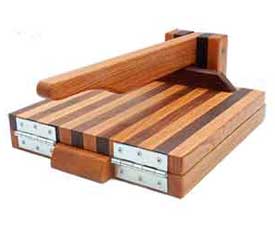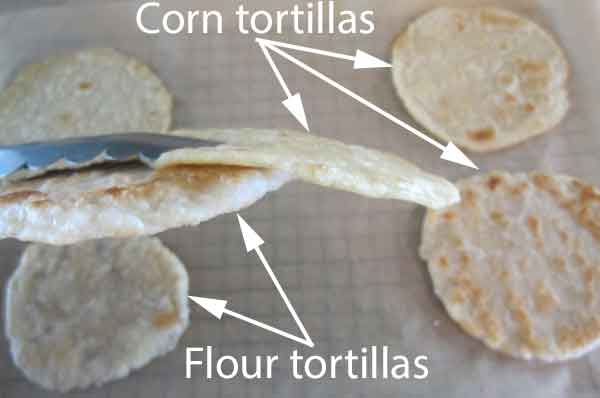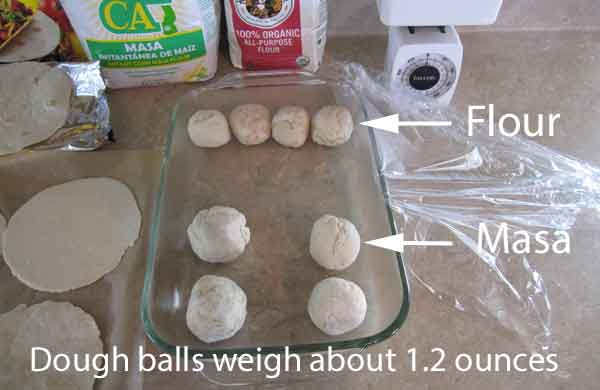This article contains affiliate links, and any purchases made through those links may result in a small commission.
After years of making homemade tortillas with a rolling pin, we finally bought a small tortilla press and now our tortillas come out perfect, and the tortilla press saves us a lot of cleanup time. There are quite a few tortilla presses on the market, so consider which size tortilla you normally make (or buy), then decide how much you want to spend.
There are three basic choices for tortilla presses: aluminum, cast-iron, or wood. Typically the tortilla presses range in size from 6-10" diameter, and weigh between 2-8 pounds. There's also an electric model that flattens the tortillas and then cooks them. There are pros and cons to each type of tortilla press and here's a basic overview:
Aluminum tortilla press: The aluminum tortilla press is small and lightweight, less expensive than cast iron, and is easy to transport. Their size allows them to fit inside backpacks to take on camping trips (fresh fish tacos anyone?). Next time someone invites you to a barbecue, toss the tortilla press in the car with a container of pre-made masa dough balls and let your host throw them right on the grill. Plus, tortilla presses are easy enough to use that kids can help make the tortillas. There are many aluminum tortilla presses available in all price ranges. We bought the 6" Fox Run aluminum tortilla press for $18 on Amazon
Cast-iron tortilla press: The cast-iron tortilla press is heavier than aluminum, but the weight makes it a bit easier to press out the tortilla, which is good if you're making a lot of tortillas one after the other. The weight is also a benefit when making flour tortillas which don't always flatten as easily as corn tortillas due to the gluten in the flour. The cast-iron press is not as easy to transport due to the weight, and a good quality cast-iron press is usually more expensive than an aluminum press. The Victoria 8" cast-iron tortilla press is a popular choice with Amazon customers.
Electric tortilla press: Most electric tortilla presses aren't just for making tortillas - you can make other flatbreads such as gyros, pitas, and roti. The electric tortilla press flattens the dough similar to the hand-operated presses, but you can cook it right in the tortilla press. They have a wide range of features and a few things to check are timers, non-stick coating, and since it's larger than the other presses, see if it allows for being stood on end so it takes up less storage space. The CucinaPro electric tortilla press has a decent amount of reviews and Q&A so that might be a good place to start.
 Wooden tortilla press: The wooden tortilla press is the most traditional tortilla press (other than making the tortillas by hand), and they add a certain amount of charm to any kitchen decor. A well-made wooden tortilla press is expensive, but some are almost works of art and can become a treasured family heirloom that can be handed down to the next generation of cooks. The beautiful wood tortilla presses made by Central Coast Woodworks of California are available on Amazon and come in several sizes and styles including oak, oak and walnut, and maple, oak, and walnut. They're not cheap, but they're handmade and it certainly shows. The image shown is the oak and walnut model.
Wooden tortilla press: The wooden tortilla press is the most traditional tortilla press (other than making the tortillas by hand), and they add a certain amount of charm to any kitchen decor. A well-made wooden tortilla press is expensive, but some are almost works of art and can become a treasured family heirloom that can be handed down to the next generation of cooks. The beautiful wood tortilla presses made by Central Coast Woodworks of California are available on Amazon and come in several sizes and styles including oak, oak and walnut, and maple, oak, and walnut. They're not cheap, but they're handmade and it certainly shows. The image shown is the oak and walnut model.
Many Internet sites say tortilla presses are only for making corn tortillas, because the gluten in the flour tortilla is too elastic and the flour tortillas need to be rolled out with a rolling pin. That's true to a point, and the flour tortillas are definitely thicker and harder to work with than the corn tortillas, but it's not like they're inedible. They're just thicker, smaller diameter, and a bit chewier than corn tortillas; sort of like pita or naan bread. To make flour tortillas we still use the tortilla press to get the basic circular shape, then use a pastry roller (Amazon) to finish flattening the tortilla. If the tortilla dough keeps springing back, just let it rest for a minute. The image below show the difference in thickness between the homemade flour tortilla and the homemade corn tortilla.

Using a tortilla press is easy and doesn't require any exceptional strength or skill. It's also a kid-friendly activity so definitely let them join in. Here's how to make homemade tortillas with a tortilla press:
How to use a tortilla press:
Some folks spray the paper or plastic with non-stick spray, but we don't use any spray and haven't had a problem peeling off the paper. Parchment paper works well and can be reused at least a half-dozen times. The image below shows the tortilla dough balls ready to be pressed.

Here's a video showing how easy it is to make corn tortillas using the tortilla press: